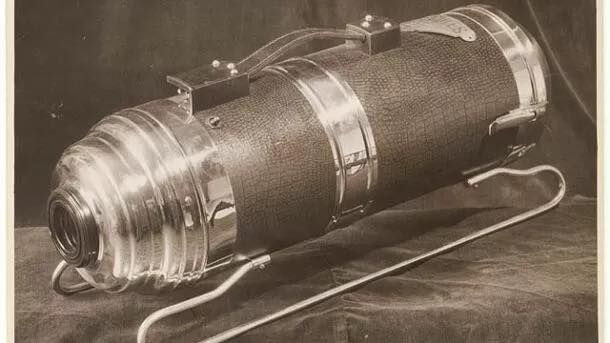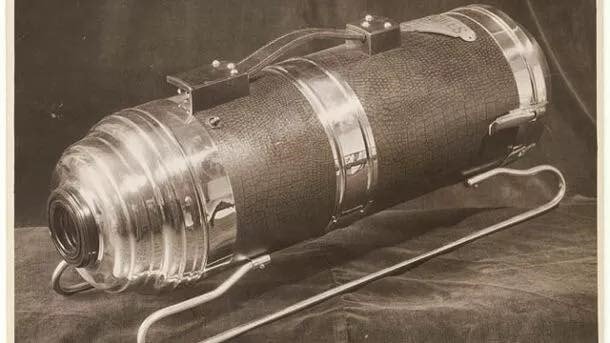We can always be sure of one thing: things change with time. Nothing will prevent this from taking place. Situations change, people change, and technology evolves. There will always be change! Consider your own life in the past, for instance.

In reality, how much has changed? particularly in terms of technological breakthroughs. It might be a little unsettling to realize how much has changed in the past. However, it may also be revitalizing! Consider this “thing,” for instance; we venture you are unaware of its nature. We’ll wager you won’t recognize this. Therefore, it’s likely that you won’t be familiar with this unless you were alive during the 1930s. If so, congratulations! A little strange-looking? Is it not? What may this device be, if you could guess?
You may get away with not understanding what this device is. But we understand that you’re genuinely curious! This odd-looking object, which appears to be a flask or some kind of container, is the Hercules, a 1930s vacuum cleaner! Compared to modern vacuums, this vintage vacuum is very different. As I type this, I am watching my Roomba® vacuum my floor! Can you fathom what it must have been like to live in those days? How revolutionary and thrilling such a machine was at the time? However, we all take for granted how simple our lives have gotten as a result of advancements and technology in the modern day.
Back then, the Hercules vacuum cleaner was an incredibly chic and advanced device. The one in the top photo cost a lot of money since it was coated with crocodile leather. The fact that it was sold during the Great Depression when many families were barely able to make ends meet, let alone purchase a Hercules, added to its already opulent status.[1] Try showing your kids this item if you know what it is, and see if they can guess! Without a doubt, they won’t recognize this!
It may surprise you to learn that the common broom wasn’t even refined until 1797. A farmer in Massachusetts saw his wife struggle with sweeping, so he set out to make one that did the job well. His broom, dubbed broomcorn, quickly gained widespread recognition. It makes sense if humans become lazy over time! A few new brooms and sweepers appeared and vanished, and the first true vacuum cleaner wasn’t invented until the 1860s by Daniel Hess. “My invention consists in drawing fine dust and dirt through the machine using a draft of air,” he states in his patent.
Then, Chicago’s Ives McGaffey took it a step further in 1869. In actuality, though, his invention was more difficult to operate than a standard broom. According to his patent, “the object of my invention is to obviate these difficulties is the accumulation of dust and dirt/in dwelling-houses, which is a source of great annoyance to all good housekeepers.” Regretfully, his creation was a failure.
Numerous designs appeared and vanished. However, the vacuum cleaner was reinvented by James Murray Spangler. James, a 60-year-old humble janitor from Canton, Ohio, toiled diligently to refine his idea. His health suffered as a result. His machine was superior to the others since it was portable in addition to being upright. The rudimentary device functioned effectively, drawing dirt in and expelling it into the pillowcase that was fastened. After receiving a patent for it in 1907, Spangler left his position to found the Electric Suction Sweeper Company.
The air flow was produced using a ceiling fan motor with paddle blades. He journaled it to a revolving brush he had taken from a carpet sweeper using a leather belt. Without a motor-driven brush, nobody was able to get the carpet clean.
When he encountered financial difficulties, he sold his business to his cousin, Susan Hoover, giving birth to The Hoover!
